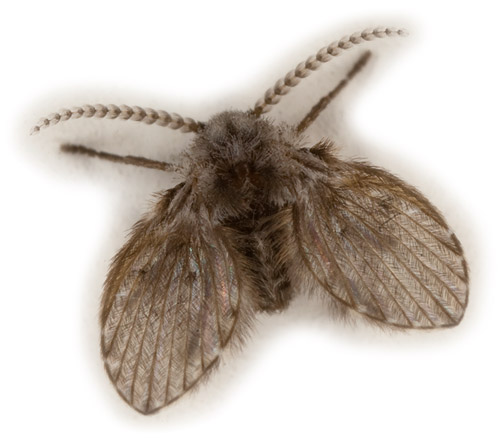Drain Flies - What are they? How do I get rid of them?

Clogmia albipunctata is a species of fly in the family Psychodidae (Diptera), with a worldwide distribution, and is commonly associated with human habitation.
Other names for this insect include drain flies, sewer flies, filter flies or bathroom flies. Due to their hairy appearance, with dense setae on their bodies and long antennae, these insects are also referred to as moth flies or moth midges.
Although somewhat moth-like in appearance, these flies can be easily recognized by having only 2 true wings with distinctly parallel veins. Adults can vary in color from dark to light gray or tan, with spots on their wings, and a total body length of 2-4 mm (1/16-3/16”).
Where do drain flies naturally occur?
These flies occur naturally in shaded locations containing moist, decaying organic matter, such as wet wooded areas or swamps.
They are also commonly associated with:
- sewage treatment plants and sewer drains
- wet compost areas
- garbage cans with standing water
- clogged gutters
- potted plants with wet soil and standing water
- household drains
Adult flies can sustain themselves by consuming only water or flower nectar, and live for around 12 days. They are weak fliers, and spend much of their time at rest. Larvae develop in wet conditions, molting through 4 instars and feeding on decaying organic matter for approximately 18 days before pupating, which takes about 5 days. Their total life span is about 35 days.
As their common names imply, these are often bathroom pests in the home. They mostly inhabit drains that are used infrequently, such as a guest bathroom shower drain, where water collects in a trap and sits for long periods of time. Larvae develop in this stagnant water, feeding on soap scum and other organic sludge occurring on the inside surfaces of drains and plumbing (algae, fungi, bacteria).
They may also be found where water accumulates beneath leaking pipes or drains. Larvae can also be introduced from sewer pipes that burp or back up into a home. Adults are mostly observed perched on walls or bathroom counters.
Due to their size and coloration, they are rarely noticed outdoors. Although they are poor fliers, adults can be blown great distances by wind, and may enter through unscreened windows. They may be attracted to lights at night.
Are drain flies a health hazard?
While drain flies are generally considered a nuisance in the home, they are not themselves necessarily unsanitary. They are not attracted to human foods and do not bite or sting humans or other animals, nor will they harm agricultural or ornamental plants. However, they do breed in unsanitary conditions, and their presence suggests a rich source of moist organic material in stagnant water in the vicinity.
In nature they feed on organic matter, helping to purify water and are themselves a palatable meal for many other small insectivorous, both as larvae and adults.
How do I get rid of drain flies?
Adults are covered with a layer of fine water-repelling hairs, making them difficult to drown. Likewise, eggs and larvae are aquatic, but can also resist periods of dehydration. Control of an infested drain requires thorough cleaning and maintenance for at least 3 weeks or longer to break the life cycle.
Adults may congregate at or near windows, but killing adult flies is not effective control. Aerosol pesticides for killing “flying insects” are not very effective, and must be registered and labeled for indoor use.
No insecticide products are registered for use in drains or sewer systems, so pouring any pesticide product down a drain should be discouraged. These products are unlikely to work against the intended pests, and can cause significant damage to a sewer or septic system. Likewise, sticky fly paper or UV-light traps can capture some adult flies, but will not eliminate an infestation.
For effective control, larvae food sources must be eliminated to interrupt development and prevent more adult flies from emerging and continuing the life cycle. Sink drains, toilets, floor drains, tub drains, and leaky shower pans are all potential breeding sites where organic matter can build up in dark wet conditions.
A clear plastic cup or glass jar, coated inside with vegetable oil or petroleum jelly, can be placed over a suspected drain. This will effectively trap adults emerging from the drain. A plastic bag can also be taped over the drain, or clear adhesive tape can be placed over the drain to monitor and capture emerging adults. These methods can help a homeowner identify a source of infestation and breeding sites, as well as provide specimens for identification.
Periodic and thorough cleaning of drains with appropriate chemical cleansers is recommended to dissolve and remove organic food sources. Foaming agents that break down gelatinous scum deposits can be useful. High-pressure drain cleaning services can eliminate organic food near the end of the drain, as well and through the entire length of the drain, reducing the likelihood of larvae returning. A population may be emerging from more than one drain or breeding site simultaneously. Inspect and clean all potential drains in the vicinity to increase success of control measures.
I've cleaned the pipes, but there is still an infestation. What is wrong?
An ongoing or recurring infestation, despite careful sanitation of all drains, can indicate a broken pipe or leak under a slab or in a crawlspace beneath the home. In industrial or commercial settings, drain flies may breed in sludge in drain pipes, large air conditioning or refrigeration drain pans, or the bottoms of elevator shafts that collect water and debris.